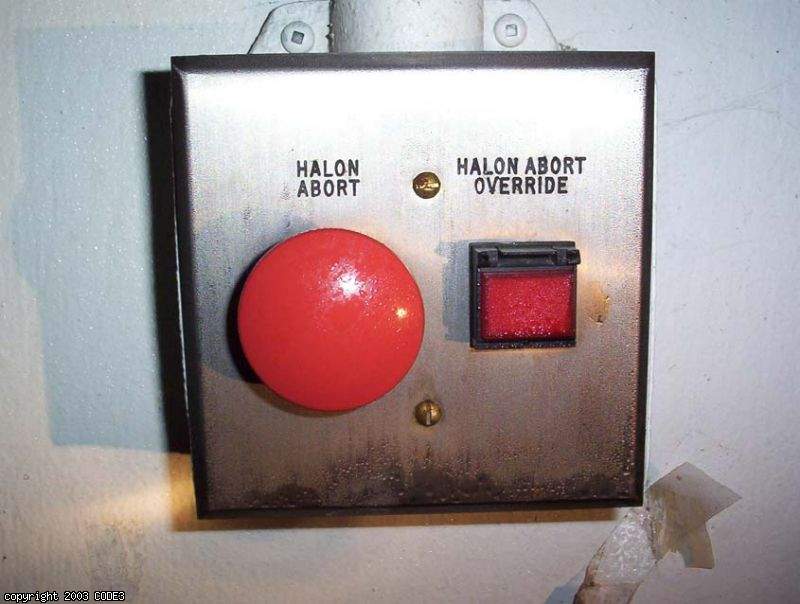| Posted by Rust |
8/30/2003 4:18 PM | remove |
Fool! How many times must I tell you, halon is lethal to humans! Sigh.
|
 |
| Posted by MacGyver |
8/30/2003 4:58 PM | remove |
The abort and override are to allow people to get out. When the fire suppression system detects a fire, it sounds all kinds of bells and whistles, allowing people to get the fuck out of there before the system actually releases the halon (which will pretty much kill you no matter what, as it displaces all the oxygen and fills the room). The abort button is most likely a delay button. You hit that to stop the system before it finishes the countdown. This model has an abort and abort-abort buttons. Many just have a single hold button that you have to hold down. This is for places where a guy might be inside the floor or ceiling working on wiring or some such thing. One other guy would always be stationed at the hold button in case the system went off. This way, the worker would have enough time to get to safety before the halon went off or a false alarm is cancelled.
|
 |
| Posted by Guwag |
11/20/2003 10:47 PM | remove |
I remember in 1997 I was working in IT at a Nuclear Power Plant in the UK and all the server rooms had Halon systems which were NEVER armed when there were personnel in the room. You had to be very careful though when re-arming the system on exiting the room because if you turned the key one position too far it would go into alarm mode and release LOL. (Think I still have my Halon key somewhere too) There were also manual releases attached directly to the halon bottles in the rooms, a sort of "pull-and-run-as-fast-as-you-can" system :D
|
 |
| Posted by Decoy |
11/24/2003 4:22 PM | remove |
I never did see this switch in there, only O2 and O2 Override switches.
|
 |
| Posted by butane killer |
12/18/2003 5:48 AM | remove |
oooo. fascinating info :-D *nod*
|
 |
| Posted by EvilSpork |
1/5/2004 7:10 AM | remove |
Halon is only deadly to humans if it's released and displaces all the air in the room, as far as I know. It extinguishes fires by displacing all available oxygen. I wonder what it's being replaced with? CO2 sounds like a good alternative, only if it's combined with water from sprinklers in the heat of a fire, it forms every machine's best friend, carbonic acid...
|
 |
| Posted by Conundrum |
2/21/2004 5:55 PM | remove |
I'm not sure what the chemical compound of halon is, but it is an inert gas that displaces all oxygen in the room, causing hypoxia, now there are new forms of "halon" they are similar, but either do not contain cfcs or do not contain as much, we have a "halon" system in our datacenter, and yes even though it is a diferent gas, because of the compound makeup and how it works its still classes as halon, but sometimes you will se it with diferent numbers usualy 2 letters dash 2 numbers. anyways back on topic, it causes hypoxia, and results in death. now, the newer ones after the gas has been released, usualy someone can still breath unconciosuly, in other words, not enough oxygen to keep them concious, but enough not to kill them, or cause brain damage due to lack of oxygen, caused by hypoxia. now in most places that use halon, there is usualy gas masks, with air tanks on them, and many overrides. well thats my little rant.
|
 |
| Posted by rainman8889 |
6/7/2004 12:44 AM | remove |
I worked at a data centre for years and the Halon alarm was a unique sound (like a sick duck) so that the workers could tell if it was a Halon dump or another type of emergency.
|
 |
| Posted by Gunslinger |
8/8/2004 6:30 PM | remove |
Actually CF boats/submarines still use a halon system. They claim it only knocks you out and is not deadly.
|
 |
| Posted by Conundrum |
8/16/2004 5:05 PM | remove |
Well, yes and no, the old stuff leaves "some" oxygen in the air, but not enough to sustain a human body for more than maybe 2 minutes, after that the body starts to suffer from expoxia, and since the lack of air to the brain, causes brain damage. The new Halon leaves more oxygen, enough to keep a few persons in an unconcious, but life sustaining state for I believe up to 2 hours.
|
 |
| Posted by Roadwolf |
8/21/2004 2:46 PM | remove |
new "halon" isnt called halon... it is called CleanGuard. And it is also enviormentally friendly.
|
 |
| Posted by mgruss |
11/6/2004 8:11 PM | remove |
Halon is not illegal to use, although it is not manufactured anymore. You can have a system refilled with "recycled" halon.
|
 |
| Posted by atomx |
6/2/2005 4:33 PM | remove |
The most commonly used are halon 1211 (bromochlorodifluoromethane) and halon 1301 (bromotrifluoromethane).
|
 |
| Posted by himself240 |
12/29/2006 1:23 AM | remove |
Lol an abort the abort button...
|
 |
| Posted by Bman505 |
3/26/2010 3:29 AM | remove |
The power plants that have worked at have had the halon system removed from the gas turbine areas and been replaced with CO2 but they do not have as great extinguishing power. Therefore needing twice if not 3 times the amount of bottles.
|

 order your copy of Access All Areas today!
order your copy of Access All Areas today!


